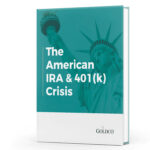Silver, often overshadowed by its more glamorous counterpart gold, has been a staple in investment portfolios for centuries. Its historical performance as an investment offers a fascinating insight into the dynamics of precious metals markets. This article provides a comprehensive overview of silver’s journey as an investment, highlighting key trends and significant price movements.
1. Silver’s Early Role in Currency and Trade Silver has been valued for its utility and beauty since ancient times. Initially used in coinage and ornaments, it gradually became a medium for international trade, impacting economies worldwide. This early use laid the foundation for silver as a store of value and a form of investment.
.
 Your 401k and IRA are at risk. Get this important free report: The #1 reason why if you’re saving for retirement, you could be looking at a perfect storm of losing your savings
Your 401k and IRA are at risk. Get this important free report: The #1 reason why if you’re saving for retirement, you could be looking at a perfect storm of losing your savings
.
.
.
2. The Silver Standard and Monetary Value For centuries, many countries adopted the silver standard, backing their currency with the metal. This period marked silver’s importance in the global monetary system, influencing its value and stability as an investment. The shift from the silver standard to fiat currency in the 20th century brought significant changes to its market dynamics.
3. The 20th Century: Fluctuations and Growth The 20th century witnessed considerable fluctuations in the price of silver, influenced by factors such as industrial demand, mining innovations, and geopolitical events.
- Post-World War II Stability: The mid-20th century saw relative stability in silver prices, supported by steady industrial demand and controlled production.
- The 1970s Silver Boom: The 1970s marked a significant boom, with prices reaching unprecedented highs due to market manipulation known as the ‘Silver Thursday’ crisis, coupled with high inflation and economic uncertainty.
- Late 20th Century Volatility: The latter part of the century saw a return to volatility, with prices impacted by fluctuating industrial demand and investment trends.
4. The 21st Century: A New Era for Silver The turn of the millennium ushered in a new era for silver.
- Early 2000s Growth: The early 2000s saw a steady increase in silver prices, driven by growing industrial demand, particularly in electronics and photovoltaics.
- The 2008 Financial Crisis: The 2008 financial crisis led to a surge in silver prices as investors sought safe-haven assets, pushing prices to new highs.
- Recent Trends: More recently, silver prices have been influenced by global economic conditions, technological advancements, and investment demand, showing resilience and adaptability.
5. Silver as a Modern Investment Today, silver is considered a versatile investment, appealing to both industrial sectors and individual investors. Its dual role as an industrial metal and a precious metal makes it unique in the investment world.
6. Investment Forms: Bullion, Coins, and Stocks Silver can be invested in various forms:
- Bullion and Coins: Physical silver remains a popular investment, with bullion and coins offering tangibility and intrinsic value.
- Silver Stocks and ETFs: Silver mining stocks and ETFs provide exposure to silver prices without the need to physically hold the metal.
7. The Role of Silver in Portfolio Diversification Silver’s historical performance demonstrates its potential as a diversifier in investment portfolios. Its price movements often differ from other assets like stocks and bonds, providing a hedge against market volatility.
8. Risks and Rewards Investing in silver involves balancing risks and rewards. While it offers potential for growth, especially in times of economic uncertainty, it can also be subject to price volatility and market fluctuations.
9. Future Prospects The future of silver as an investment looks promising, given its growing industrial applications, particularly in renewable energy and technology sectors, and its enduring appeal as a safe-haven asset.
10. Remember this: Silver’s historical performance as an investment is marked by periods of stability, growth, and volatility. Its unique position in the market as both an industrial and precious metal offers diverse opportunities for investors. As global economic and industrial landscapes evolve, silver continues to be a relevant and dynamic component of investment portfolios.
This article delves into the historical performance of silver as an investment, tracing its evolution from ancient times to the present day. It highlights the key market trends and significant price movements that have shaped silver’s role in investment portfolios, offering insights into its enduring value and future prospects.
